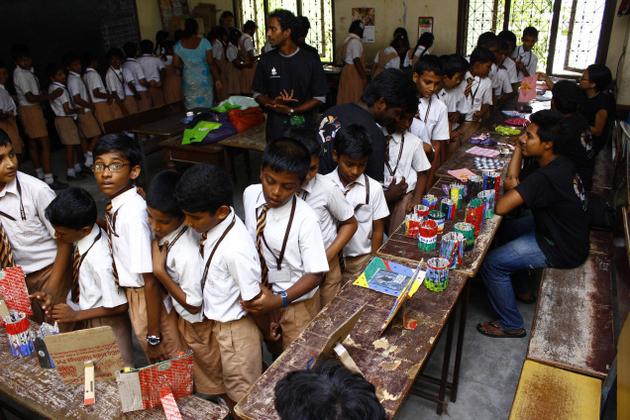Innovative: Using trash for cash.
So you have a load of unwanted stuff cluttering up your room. Here’s something you can do with them…
To teach is a pleasure and when it’s the fun kind of teaching, it’s even more pleasurable. Three schools where handpicked by the students of the Department of Communication, Madras Christian College, Chennai, for their Public Relation campaign ‘Cut the Crap’, which was based on recycling.
Newspapers became beautiful files, bottles pen stands, cardboard became photo frames and bits of cloth transformed into surukkupais. There is no such thing as ‘waste’ and the material in our homes can be made into something extraordinary with very little investment.
An exhibition ‘Recycled Creativity’ was set up in Madras Christian College, of a home which has its interiors made out of newspapers, cardboard, tins, bottles, cloth and everything we see as ‘crap’, to show how our rooms can be re-worked with just a little bit of creativity and a whole lot of trash.
The campaign went on for five days. On three days children from Balar Kalvi Nilayam, Vepery, Clarke School for the Deaf, Mylapore and Presidency Girls Higher Secondary School, Egmore participated.
About 250 children from these schools loved what they did and the schools are also planning to teach their school mates.
DEVAKAR R., VIII, Balar Kalvi Nilayam, Chennai
I made a pen stand and the idea was very new to me. I never thought waste could be turned into something as good and useful as this. I felt happy and I learnt so much, I felt loved and that encouraged me a lot. My friends have asked me to teach them.
PAVITHRA J., VII, Presidency GHSS, Chennai
We have never done anything like this before; it was a lot of fun and I really liked it. I want to teach everyone what I have learnt beginning with my little sister and my friends from other schools. I learnt how to make a plaited file and will use this to put all my papers in it. If I make more, I’m going to sell it at Rs. 50/- each.
SIDDHANTHA DAMALA, VIII, The Clarke School for the Deaf
I enjoyed this very much. Found it very interesting as well. I will teach my friends and family.
As told to Divya Thiagarajan and Nirmal Joseph Sebastian
Photos (Quotes): Prashanth Gurunathan, Divya Thiagarajan and Nirmal Joseph Sebastian
Make a pen stand
Method
1. Tear old newspaper into rectangular shapes and keep the size according to the water bottle you have cut. You may need around 30 to 35 of these.
2. Roll the rectangular sheets of paper and stick the end as you finish it.
3. Now glue the rolls to your water bottle
4. Cut the extras on the top of your pen stand in any pattern you like.
5. Decorate with paint, sequence or you could just leave it plain.
6. Once you let it dry, your pen stand is ready!
Photos: Prashanth Gurunathan
source: http://www.TheHindu.com / Home> Life & Style> Kids / by Divya Thiagarajan / October 29th, 2012



